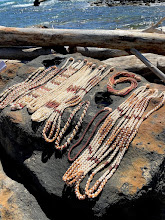When it comes to Kahelelani shell leis, there are five main aspects that determine the overall worth of a piece.
1. Color: The shells in a perfect lei have been diligently sorted for color. If the desired style is monochromatic, then the shells should be matched as close as possible. For instance if a necklace is to be pure burgundy, then no common brownish shells should be present to detract from the overall appeal. In a mixed color style, the colors or color combinations, should compliment each other.
http://www.janjirarities.com/shell_necklace.html 2. Luster: Natural shell luster is a crucial feature when shopping for a shell lei. Shells that shine with a brilliant luster similar to pearls are more attractive.
3. Flaws: Each individual shell should be near-flawless. This means it should be free of chips and cracks. Also, a well made piece will only contain shells with holes that have been pierced by the stringer. Often the Kahelelani shell has other holes created from an octopus feeding on the tiny creature that lived inside. The shells should also be free of debris and grains of sand.
4. Size: The most exquisite pieces are made with a uniform size or unique taper which helps create symmetry within the lei. Leis made from the smaller Kahelelani shell are extremely difficult to make, thus making them more valuable.
5. Craftsmanship: The quality of craftsmanship should be visibly apparent. The shells should be pierced in exactly the same place on each shell to ensure a smooth transition between shells. The thread itself should not be visible between the Kahelelani shells. Also, when placed correctly, the shells will form a tight fitting pattern that will prevent the shells from turning and upsetting the overall style of the piece.
We hope these information will be helpful to you in finding a beautiful piece of Hawaiian shell jewelry. Mahalo for visiting Janjirarities! Janjira
Please visit Janjirarities for more information. Janjira
Kahelelani shell colors
The Hawaiian Islands have a rich and valuable indigenous culture that survives today as seen in the hula, surfing, chanting, and lei making. Hawaiians created exquisite shell jewelry using Kahelelani shells. These jewels from the sea are still collected and strung in the same manner the ancients employed.
The Kahelelani shell is the most sought after of the rare Niihau and Kauaian shells. It is the smallest and therefore the most difficult to collect and string. The Kahelelani is also the most colorful shell used in Niihau and Kauaian shell leis.
Many variants of kahelelani shell leis are named by the Niihauans according to subtle differences in shells color and pattern.
The various colors include:
Dark red burgundy color, Pink flower Kahelelani, Strong pink Kahelelani, Brown Kahelelani, Green Kahelelani, Black Kahelelani, White Kahelelani, Yellow Kahelelani.
http://www.janjirarities.com/gallery.htmlLabels: Hawaiian Heirloom jewelry www.janjirarities.com











